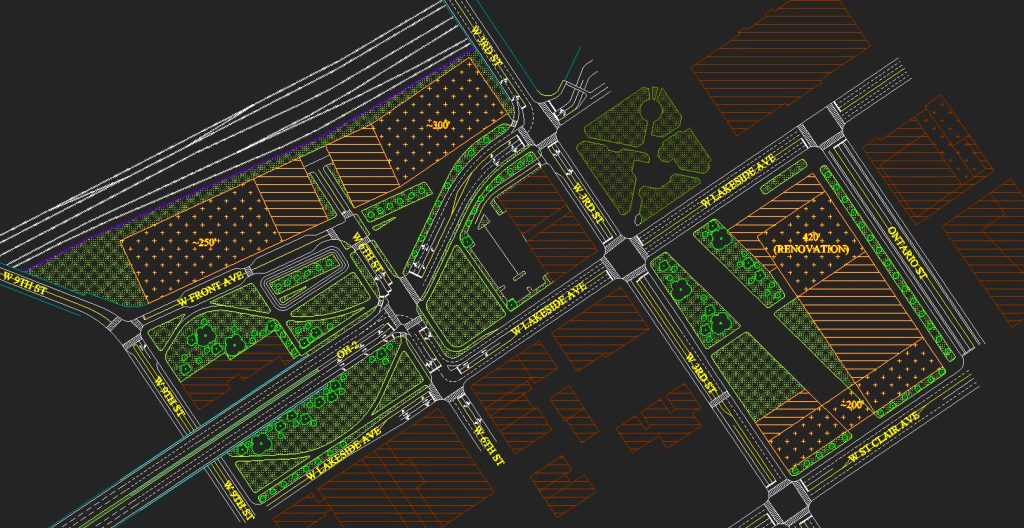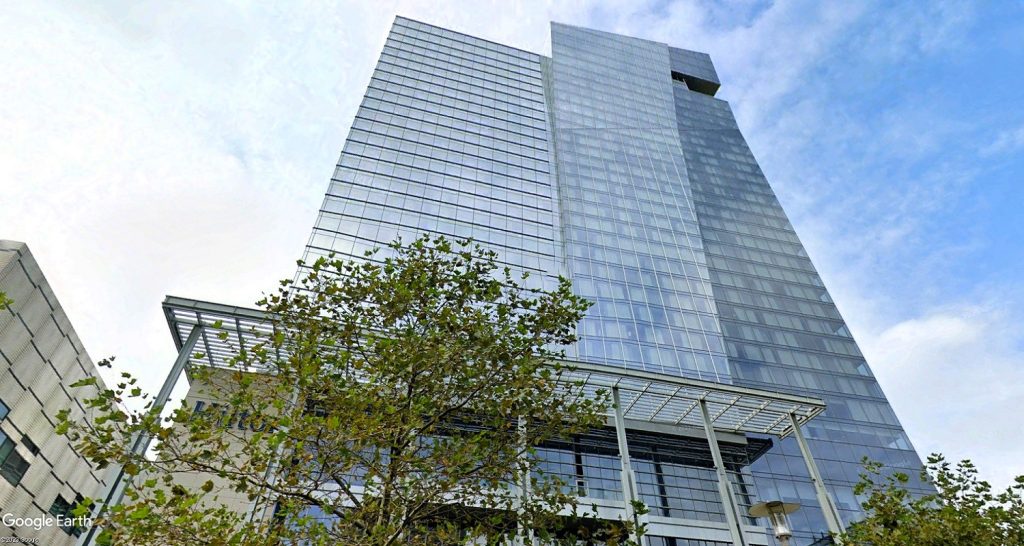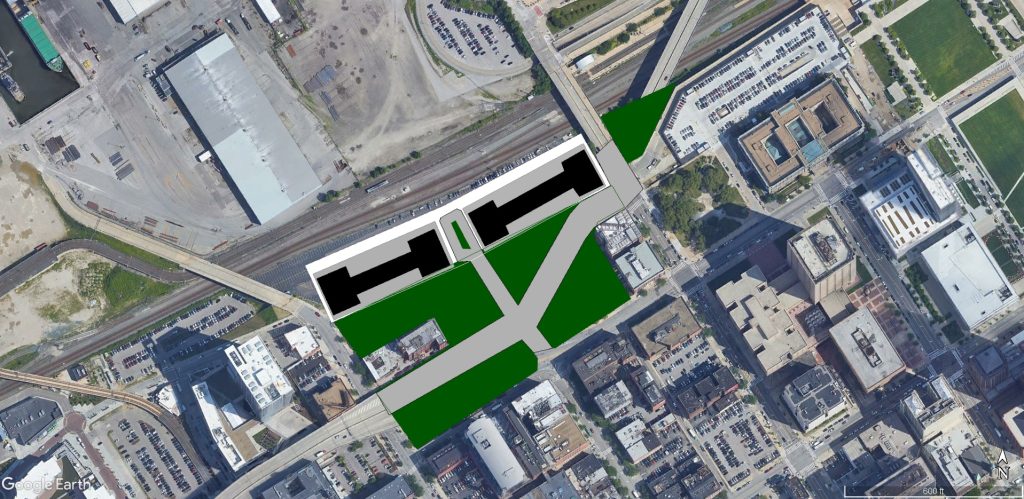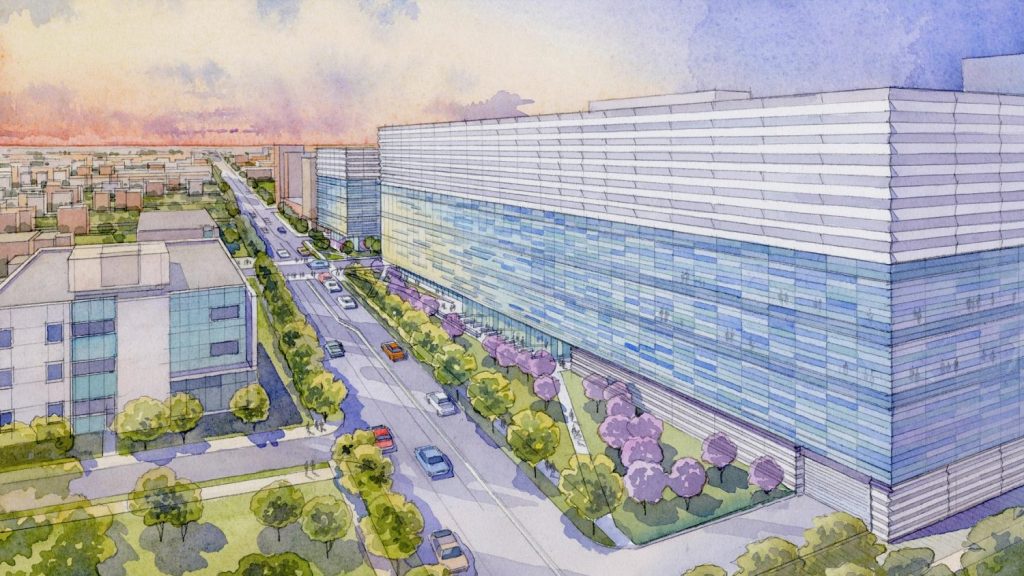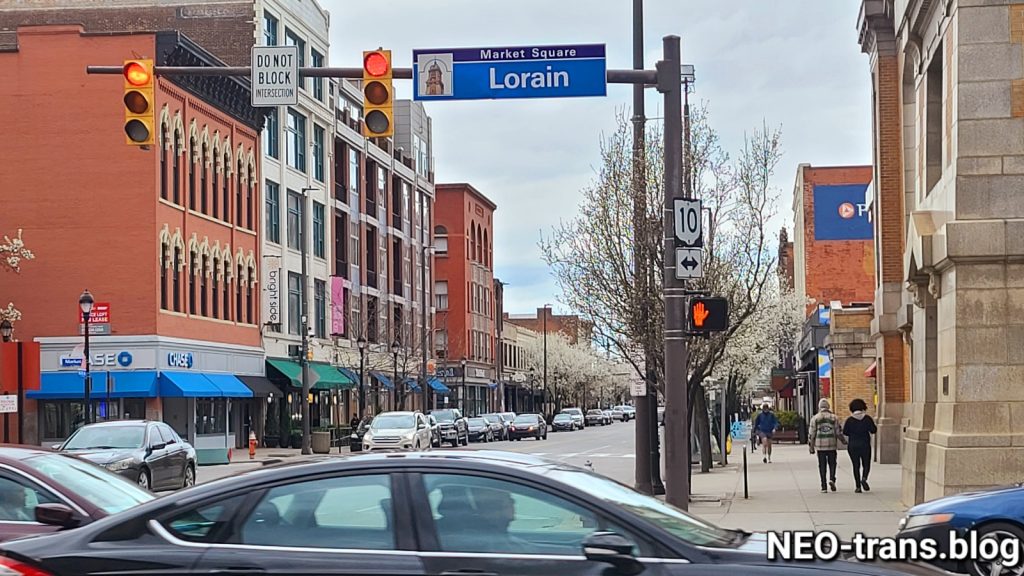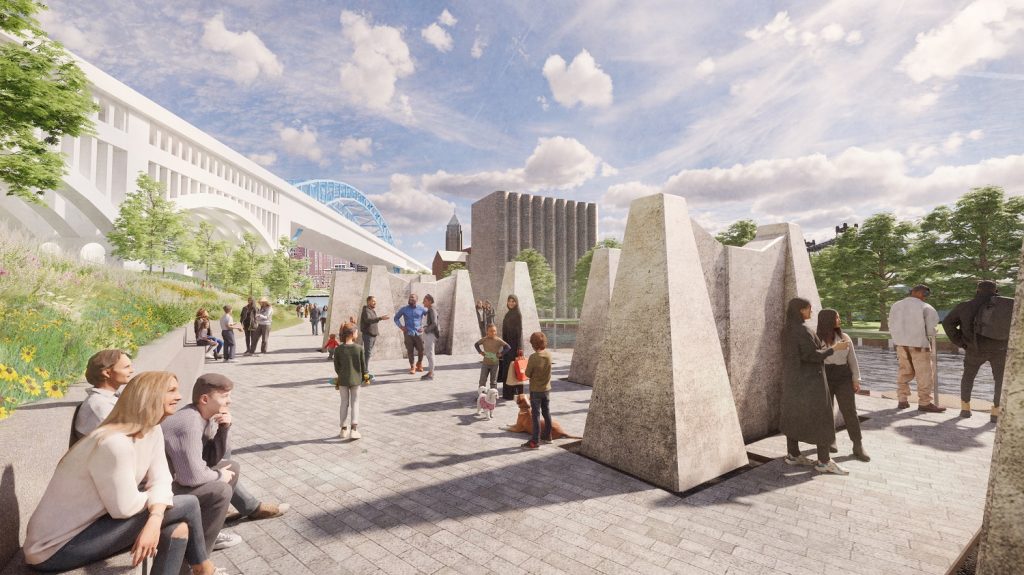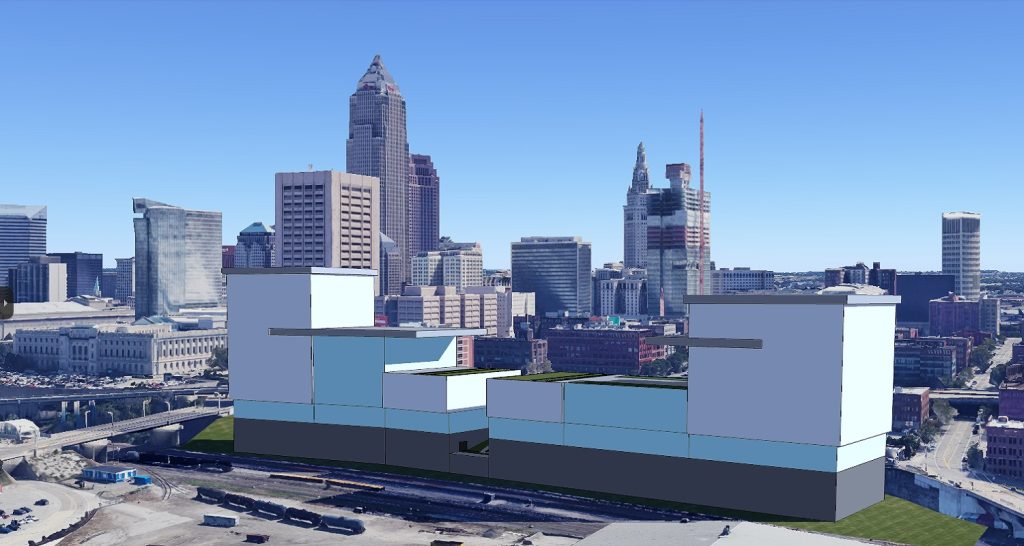
This is an unofficial conceptual massing (a rendering to show scale, not design) of what a new Consolidated Courthouse could look like if built near the lakefront at The Pit between West 3rd Street, at left, and West 9th Street, at right. In between, atop five levels of structured parking and a layer of public atriums of shops and restaurants could be two courthouse structures of nearly 450,000 square feet each. Such a complex would not only meet Cuyahoga County’s requirements but also provide stadium parking relocated from a to-be-developed lakefront (Ian McDaniel). CLICK IMAGES TO ENLARGE THEM.
Jail, courthouse, downtown pivot all doable

A COMMENTARY
Fifteen years ago, when the Great Recession could let someone go bowling down East 9th Street without hitting anyone, three major construction projects were about to get started and provide the city of Cleveland with much-needed economic stimulus. Back then, construction of the new Huntington Convention Center, the Flats East Bank redevelopment, and the new Inner Belt highway bridges represented a total public works investment of nearly $1.5 billion.
Those three projects couldn’t have come at a better time for Cleveland. The city was hurting from thousands of bank layoffs (including the loss of National City Bank’s headquarters), numerous other job losses, and a housing foreclosure crisis. The trio of megaprojects and their thousands of construction jobs meant new income tax revenues to sustain city services. And, for many people, the projects bolstered their hope for the city’s future.
Although the city and Cuyahoga County aren’t so wanting these days, some aspects of the economy are still reeling from the latest economic downturn — the COVID-19 pandemic and the remote work trend. Downtown Cleveland’s economy in the last 60 years was built around the office market. Of Greater Cleveland’s 30+ million square feet of office space in 2019, nearly half of that inventory was downtown, according to brokerage JLL Cleveland.
While Downtown Cleveland is diversifying with more than 20,000 residents, it still has a long way to go to wean itself from its dependency on the office market. Vancouver, BC, for example, has a comparable amount of office space as downtown Cleveland, but is much more vibrant. Its urban core is a hub for international trade, technology, film/television, retail, tourism and has more than 122,000 residents. It underscores that a downtown doesn’t have to rely on office workers.
Funding for a major part of downtown’s diversified future was provided last week for three new and huge building projects that could give downtown a nudge. There is going to be a lot of construction resulting from this. If you know someone who is in the construction industry but their business doesn’t have a presence in Greater Cleveland, I would give them a nudge, too.
By a slim 6-5 majority, Cuyahoga County Council members voted to extend a 0.25-percent countywide sales tax that was budgeted to generate about $65 million this year, or nearly $4 billion over the next four decades, assuming an average of 2 percent of economic growth per year. Last year, Cuyahoga County GDP grew at 3.3 percent. The 0.25-percent sales tax was originally approved by the county in 2007 to support reconstruction of the existing convention center.
Because of the renewal and extension of the sales tax, several major construction projects can proceed. Of greatest priority is a new $750 million consolidated jail campus at Transportation Boulevard and Interstate 480 in suburban Garfield Heights. It would replace downtown’s outdated and, according to the Ohio Department of Rehabilitation and Corrections, unsatisfactory jail facilities. By relocating the county jail away from the urban core, it should also provide an economic stimulus to downtown — assuming a new use can make up for many of the nearly 700 jail employees who will no longer be supporting downtown businesses.
County Executive Chris Ronayne’s administration is also reviewing proposals for a new or renovated Consolidated Courthouse facility downtown that could cost anywhere from $400 million to $700 million. While a bond issue serviced by sales tax revenues is the likely means of financing the new jail, a wide variety of financing tools could be utilized for the new courthouse such as county debt, a lease-back, sale of the existing 7-acre Justice Center campus downtown, and other mechanisms. The availability of the sales tax revenue is going to be a key part of any funding strategy.
“With county council’s vote, we have taken another step towards the construction of a new jail and the funding to renovate or build a new facility for the courts,” Ronayne said in a written statement. “The new jail facility will improve the services, conditions and outcomes for those in our custody and reflects our commitment to investing in the safety and well-being of our residents. We look forward to partnering with council on further efforts to improve our justice system and other core county services.”
And a third major project is reportedly in the works. As noted last month, NEOtrans has spoken with developers, architects, engineers, construction managers, brokers, lawyers, financiers and county officials to get a sense as to what direction the county may go with its Consolidated Courthouse project. Since then, NEOtrans has learned more, including that the county has interviewed the seven teams that submitted proposals for the new courthouse and/or purchase/redevelopment of the Justice Center campus.
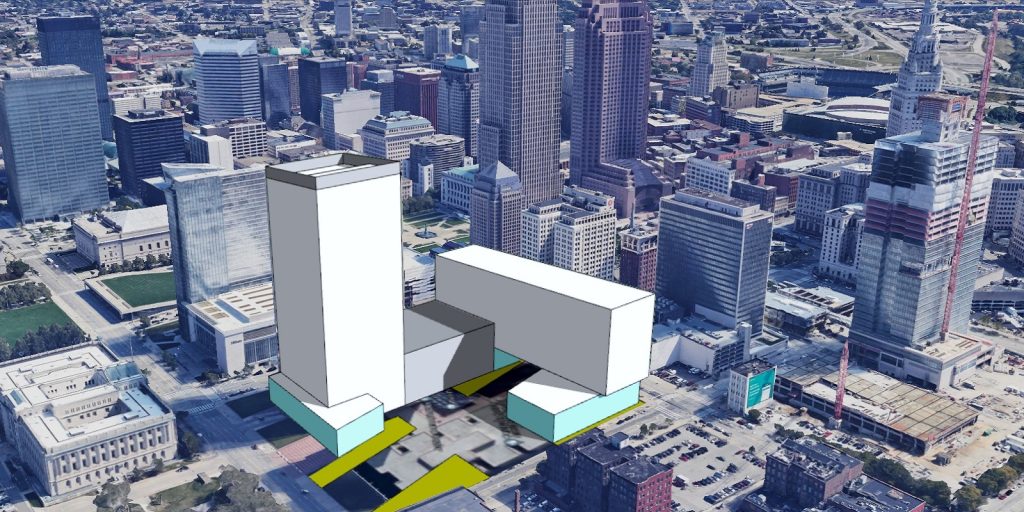
Another unofficial massing, this time of the current Justice Center site if the 420-foot-tall courthouse tower was retained but gutted down to the superstructure and rebuilt with a new use, such as a convention center hotel with the rest of the site redeveloped with meeting, collaboration, research and/or technology facilities plus greenspaces (Ian McDaniel).
Based on criteria the county had used prior to the pandemic to weigh options for a new or renovated Consolidated Courthouse, and based on the proclivities of the county’s current leadership, I’m going to make a rare prediction here. I think the county wants to use this courthouse development project to help reboot the northwest corner of Downtown Cleveland.
I say “help” because, as large as the 893,120-square-foot (not including atriums or parking decks) Consolidated Courthouse project will be, it is not big enough by itself to pivot Downtown Cleveland’s economy to one that’s less dependent on the office market. And, frankly, a courthouse is still just an office building albeit a very large one. By itself, it doesn’t diversify downtown’s economy — unless it is moved.
That new site, in my opinion, is the parking lot site called “The Pit” and was submitted for consideration by Twenty-One Six Development. It is led by Beachwood-based TurnDev which is already starting preparatory work for moving one use away from the Justice Center campus — the Cleveland Police headquarters. In 2026, its new home will be in the Artcraft Building, 2350 Superior Ave. TurnDev’s proposed courthouse site, owned by the Kassouf and Coyne families, can do a lot for downtown and especially that corner of it. TurnDev has been lobbying hard for the courthouse project.
The Pit is a new-construction site that’s just one block from the existing Justice Center campus, between West 3rd and West 9th streets, south of the lakefront railroad tracks. And that should please the most influential constituency involved in deciding the Consolidated Courthouse site, collectively dubbed “The Bar and The Bench” — the city’s lawyers in the Cleveland Metropolitan Bar Association plus the judges and magistrates of Cuyahoga County. Nothing will happen without their blessing. And they don’t want any new courthouse to be a long walk from the existing Justice Center campus.
The Pit offers a large canvas on which to draw a new direction, if the financial numbers work. Its 8.5-acre site may allow a Consolidated Courthouse to be built less expensively than at the current Justice Center site. Any new construction that occurs at the current campus will have to wait years for the new police HQ and, especially, the new jail to be built. Only then can the old police HQ and jails be demolished. But if county officials can acquire a new site and start building sooner, the less inflation will eat away at their budget. Building elsewhere allows that, and will be less disruptive to existing court operations.
Furthermore, The Pit’s large site might allow the county to construct a more affordable mid-rise complex rather a pricey supertall. Shorter buildings spread over a larger area might let the Consolidated Courthouse avoid building a costly superstructure or caisson foundations to bedrock. And even if caissons are still needed, the site’s elevation is more than 55 feet lower than that of the central business district to the south of the Lake Erie bluff, thus saving on excavation costs.
While skyscraper lovers may shed tears over not getting another iconic tower, the site’s placement at the bluff would give any buildings constructed here atop a parking structure a more impressive façade, at least when viewed from the lake. Two connected courthouse buildings with 15- to 20-foot floor heights on average, 40,000-square-foot floorplates atop glassy atriums, and five levels of parking could range in height from 250 to 300 feet tall. And that’s without any decorative crowns atop them.
But for Ronayne, who has been Mister Lakefront Advocate for nearly two decades, the site offers a rare if not unique opportunity to extend the lakefront bluff and the downtown street grid to the north. At 55 feet, assuming a typical parking level height of 11 feet, five levels of parking deck can be built to make its rooftop flush with the bluff.
When spread across The Pit site, up to 1 million square feet of parking, or more than 3,000 spaces can be provided — not only for the Consolidated Courthouse but also for lakefront events. They would make up for the loss of thousands of spaces around Cleveland Browns Stadium as the lakefront gets redeveloped according to an ambitious vision that’s been coming together for more than a year.
Part of that lakefront vision is to turn the Shoreway highway into an at-grade boulevard. That includes demolishing the Shoreway bridge that has condemned the area north of Lakeside Avenue, west of West 3rd, into a mishmash of windswept parking lots. In this area, the lightly traveled Shoreway would ramp down to become a boulevard with intersections and possibly share a reconfigured bridge crossing above the lakefront railroad tracks with West 3rd. That crossing could also include an expanded if not enclosed walkway to link the Waterfront Line light-rail station with the Consolidated Courthouse.
Unlike in years’ past when all America did was try to get more cars through downtowns faster, the U.S. Department of Transportation has up to $1 billion for restoring the urban fabric of civilization. It offers a Reconnecting Communities grant program to remove divisive highways from urban centers. The Ohio Department of Transportation (ODOT) also provides road funding for economic development projects that might include a human-scale lakefront.
The person in charge of the lakefront vision and achieving any public works projects that come out of it is the city’s Chief Operating Officer Bonnie Teeuwen. She is one of the most respected public-sector administrators in Greater Cleveland. Teeuwen also knows her way around Cuyahoga County’s Public Works department and ODOT’s District 12, having served as directors of both since 2007. If anyone can achieve such grand visions as a Shoreway-turned-urban boulevard, it’s her.
In the area that the Shoreway now casts its shadow could be greenspaces and/or parcels held in reserve for future developments to make walking to/from a Consolidated Courthouse atop The Pit a pleasant experience. When a new/expanded courthouse is built, county offices can vacate the 105-year-old Courthouse Square building, 310 Lakeside Ave., and redevelop it with housing or perhaps law offices and restaurants, located right next to The Pit. That county-owned historic structure is being offered for sale or lease.
And, finally, we get to the third big project in all of this. It’s the part that can continue to diversify downtown’s economy.
So with the police HQ, county jail and county headquarters moved out, the 7-acre former Justice Center site in the heart of downtown can be rebooted. The mysterious proposals by Lincoln Property Company and U.S. Realty Advisors remain unaccounted for in this calculus, but their projects typically focus on single-tenant real estate investment and asset management efforts.
Two other proposals for the site by DBL Development LLC and DMD Development Group could either accommodate a courthouse or go in a totally different direction. That new direction sounds like an effort to expand the Huntington Convention Center and add a significant new convention hotel, possibly as large as 1,000 rooms based on rumors circulating in the real estate community.
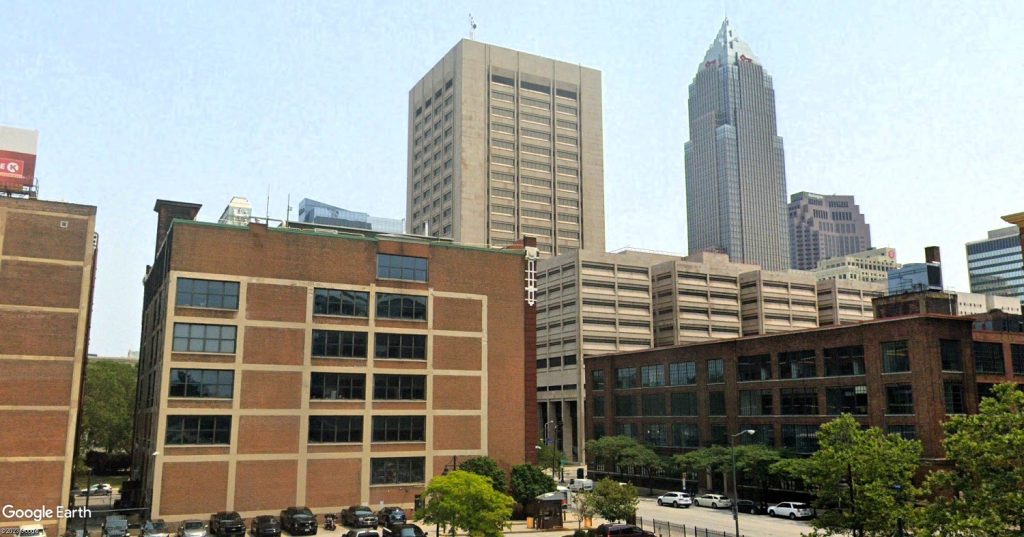
As seen from Twenty-One Six Development’s proposed site for the Consolidated Courthouse, the current Justice Center’s courthouse tower, at center, is close by. To the lower left of the tower is the county-owned Courthouse Square office building which, like the tower, is also for sale or lease (Google).
Whether three of those proposals would seek to repurpose the existing 420-foot-tall courthouse tower or knock it down is unknown. In the fourth, by DMD, it proposes to raze everything on the block and replace the 1970s-era modernist structures with recreations of classic-but-demolished buildings from Downtown Cleveland’s past, arrayed around a public green space.
The $49 million convention center expansion that’s underway on the east side of Ontario Street from the Justice Center campus may be instructive for what’s in store for the west side of Ontario. That project is converting the 120,000-square-foot Global Center for Health Innovations into meeting and exhibit spaces. And it’s connected to the 2016-built, 650-room Hilton Cleveland Downtown Hotel. But civic leaders say the expansion is barely enough to put the city in the middle of the pack of competing for national conventions. Even after its completion, both Cincinnati and Columbus will still offer larger convention facilities and attract larger events.
But what is most is intriguing is that the funding is in place for a third big project here and so is the land. That’s true even if the county decides to keep, renovate and expand the existing courthouse tower after it is thoroughly gutted and rebuilt. Although I doubt it will be kept as a courthouse by the county given the temporary courthouse relocation costs and 30-year capitalization costs projected in 2019. After the police headquarters, the existing courthouse tower was rated to be in the worst condition of the four Justice Center structures. Four years ago, the two jail blocks were rated to be in better condition than the courthouse.
Even if the courthouse tower is kept for whatever future use, a large part of the Justice Center campus is still going to be available to help pivot the northwest corner of Downtown Cleveland for a future that may be less reliant on the office market. Given that it is in public hands, unlike downtown’s acres of surface parking lots which are mostly in private hands, it can be offered for development at below-market prices to stimulate private investment, including for attracting venture capitalists, venues for innovation/collaboration, research/technology firms, affordable live/work housing and incubator businesses.
Downtown Cleveland needs a shot in the arm. Whatever county officials decide to do with this opportunity, hopefully it will help Downtown Cleveland pivot in a new direction that spurs a feedback loop of new energy and creativity. That’s what urban centers designed for hope and inclusion have achieved throughout history.
END

